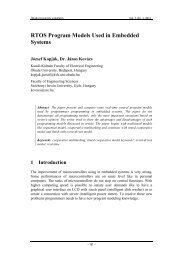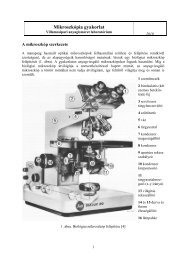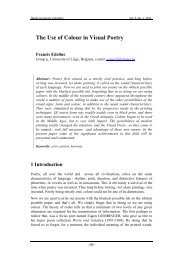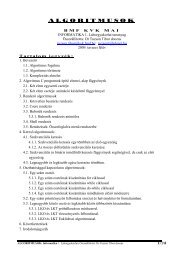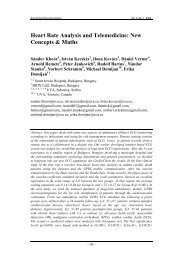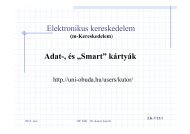Research and Development Platform for Multimedia Streaming of ...
Research and Development Platform for Multimedia Streaming of ...
Research and Development Platform for Multimedia Streaming of ...
You also want an ePaper? Increase the reach of your titles
YUMPU automatically turns print PDFs into web optimized ePapers that Google loves.
Acta Polytechnica Hungarica Vol. 3, No. 3, 2006<br />
<strong>Research</strong> <strong>and</strong> <strong>Development</strong> <strong>Plat<strong>for</strong>m</strong> <strong>for</strong><br />
<strong>Multimedia</strong> <strong>Streaming</strong> <strong>of</strong> MP3 Audio Content<br />
Andrei Novak*, Mircea Stratulat**, Daniela Stanescu**, Dan<br />
Chiciudean**, Bogdan Ciubotaru**, Razvan Cioarga**<br />
* S. C. Nadcomp S. R. L, Oradea, Romania, Phone: +40 722 17 8222, Fax: +40<br />
359 407445, E-mail: novak_<strong>and</strong>rei@rdslink.ro<br />
** S<strong>of</strong>tware <strong>and</strong> Computer Engineering Department, Politehnica University <strong>of</strong><br />
Timisoara, 2, V. Parvan Blvd, 1900 Timisoara, Romania, Phone/Fax: +40 256<br />
40 3260, E-mail: {daniela.stanescu, dan.chiciudean, bogdan.ciubotaru,<br />
razvan.cioarga}@ac.upt.ro<br />
Abstract: In the recent years, the MPEG Layer III (MP3) music compression <strong>for</strong>mat has<br />
become an extremely popular choice <strong>for</strong> digital audio compression. Its high compression<br />
ratio, <strong>and</strong> near CD quality sound make it a natural choice <strong>for</strong> storing <strong>and</strong> distributing<br />
music - especially over the internet, where space <strong>and</strong> b<strong>and</strong>width are important<br />
considerations. For example, using MPEG Layer-3 compression, 40 MBytes audio files<br />
have been compressed to approximately 3.5 MBytes. As a result <strong>of</strong> the MP3 popularity, a<br />
variety <strong>of</strong> portable MP3 players entered the market. We decided to design <strong>and</strong> implement a<br />
Hard Disk based MP3 player similar to products currently available (e.g. Creative Labs<br />
Nomad, Archos Jukebox 6000, Apple Ipod, etc.). Our goal was to design the player with<br />
minimal cost <strong>and</strong> to implement a FM Stereo Radio Transmitter module <strong>for</strong> ease <strong>of</strong><br />
connectivity. This module resolves the compatibility problems with the current available<br />
car audio systems. In the same time system flexibility <strong>and</strong> scalability as well as system<br />
evolution to more advanced architectures were the main principles that drove the<br />
development <strong>of</strong> this plat<strong>for</strong>m. The primary enhancement <strong>of</strong> the plat<strong>for</strong>m will be to switch<br />
the communication module from a analogical FM radio transmitter to digital wired or<br />
wireless communication solutions.<br />
Keywords: mp3 player, radio transmitter, hard disk, HD-based players, level shifting, i2c<br />
communication<br />
1 Introduction<br />
A digital audio player (DAP) is a device that stores, organizes <strong>and</strong> plays digital<br />
music files. It is more commonly referred to as an MP3 player (because <strong>of</strong> that<br />
<strong>for</strong>mat's ubiquity), but DAP's <strong>of</strong>ten play many additional file <strong>for</strong>mats. Some<br />
– 5 –
A. Novak et al. <strong>Research</strong> <strong>and</strong> <strong>Development</strong> <strong>Plat<strong>for</strong>m</strong> <strong>for</strong> <strong>Multimedia</strong> <strong>Streaming</strong> <strong>of</strong> MP3 Audio Content<br />
<strong>for</strong>mats are proprietary, such as Windows Media Audio (WMA), <strong>and</strong> Advanced<br />
Audio Codec (AAC). Some <strong>of</strong> these <strong>for</strong>mats also may incorporate restrictive<br />
digital rights management (DRM) technology, such as WMA DRM, which are<br />
<strong>of</strong>ten part <strong>of</strong> certain paid download sites. Other <strong>for</strong>mats are completely patent-free<br />
or otherwise open, such as Ogg Vorbis, FLAC, Speex (all part <strong>of</strong> the Ogg open<br />
multimedia project), <strong>and</strong> Module file <strong>for</strong>mats.<br />
There are three main types <strong>of</strong> digital audio players: MP3 CD Players - These kinds<br />
<strong>of</strong> devices play CD's. Often, they play both audio CD's <strong>and</strong> homemade data CDs<br />
containing MP3 or other digital audio files; Flash-based Players - These are solid<br />
state devices that hold digital audio files on internal or external media, such as<br />
memory cards. These generally have a low storage device, typically ranging from<br />
128 MB – 4 GB, which can <strong>of</strong>ten be extended with additional memory; Hard<br />
Drive-based Players or Digital Jukeboxes - Devices that read digital audio files<br />
from a hard disk. These players have higher capacities, ranging from 1.5 GB to<br />
100 GB, depending on the hard drive technology. At typical encoding rates, this<br />
means that thous<strong>and</strong>s <strong>of</strong> songs, perhaps an entire music collection can be stored in<br />
one MP3 player.<br />
In this paper we will present the implementation <strong>of</strong> a Hard Drive-based player<br />
capable <strong>of</strong> streaming multimedia audio content via wireless communication<br />
interface. This system may be used as a st<strong>and</strong> alone device <strong>for</strong> playing mp3 files<br />
or as a broadcast audio station.<br />
2 Related Work<br />
The precursors to DAP's were portable CD players <strong>and</strong> Mini disc players. Nonmechanical<br />
DAPs were introduced following the popularity <strong>of</strong> the precursors.<br />
The first Mp3 player in the world was created by SaeHan In<strong>for</strong>mation Systems in<br />
1997. The MPMan F10 was later OEMed to the American market through Eiger<br />
Labs. The first non-mechanical digital audio player on the American market was<br />
the Eiger Labs MPMan F10, a 32 MB portable that appeared in the summer <strong>of</strong><br />
1998. It was a very basic unit <strong>and</strong> wasn't use exp<strong>and</strong>able.<br />
The first Mp3 player to really make a significant impact on the buying population<br />
in America was the Diamond multimedia Rio PMP300. Diamond multimedia<br />
wisely released the PMP in September <strong>of</strong> 1988 just prior to the Christmas season.<br />
Sales <strong>of</strong> the Rio far exceeded the company’s expectations, which led to a number<br />
<strong>of</strong> large companies’ decisions to enter the Mp3 race mp3play.<br />
The first commercially available HD-based Mp3 Player was created by Compaq.<br />
It was created as a prototype personal audio appliance by Compaq's Systems<br />
<strong>Research</strong> Center (SRC) <strong>and</strong> Palo Alto Advanced <strong>Development</strong> group (PAAD).<br />
– 6 –
Acta Polytechnica Hungarica Vol. 3, No. 3, 2006<br />
The PJB project started in May 1998, <strong>and</strong> the PJB-100 product shipped in<br />
November 1999. This player was succeeded by a lot <strong>of</strong> players Creative Nomad<br />
Jukebox, Archos Jukebox 6000, Apple Ipod, etc mp3hard.<br />
3 System Overview<br />
Inspired by these HD-based players we decided to design a similar one, with<br />
minimal cost. We observed that all these players have compatibility problems with<br />
the current available car audio systems. The only way to connect them is via the<br />
RCA analog input <strong>of</strong> the audio systems. This is difficult sometimes, because a<br />
dashboard disassemble is needed.<br />
We find a solution <strong>for</strong> this problem, the wireless technology. We implemented a<br />
FM Stereo Radio Transmitter to our MP3 player. With this, the player transmits<br />
the analog audio signal on FM frequency between 88 - 108 MHz. The only thing<br />
needed to connect the player to the audio system is to tune in the correct frequency<br />
on the FM radio receiver <strong>of</strong> the audio system. In this way there is no more need <strong>of</strong><br />
a wire connection, only needed to keep the player in a range <strong>of</strong> three meters from<br />
the audio system <strong>and</strong> the signal is transmitted.<br />
The mp3 player is capable to access <strong>and</strong> read thous<strong>and</strong>s <strong>of</strong> mpeg digital audio files<br />
from a hard disk using a microcontroller. The microcontroller sends the data<br />
extracted from a file to mp3 decoder chip. This chip processing the date <strong>and</strong> send<br />
them to the digital analog audio converter (DAC). The DAC converts the digital<br />
date from the input <strong>and</strong> send analog audio signal to the output. That signal is sent<br />
to the loudspeakers <strong>and</strong> to the FM transmitter. We implemented <strong>for</strong> the player<br />
some push buttons <strong>and</strong> infra red port. With these we will be able to control the<br />
mp3 player.<br />
The push buttons are as following: Play (play melody); Stop (stop playing); Next<br />
(next melody); Prev (previous melody); Volume + (volume up); Volume -<br />
(volume down); Dir (change directory); Shuffle Mode, Normal Mode.<br />
4 Hardware Design<br />
The basic parts used in this project were: Microcontroller - AT90S8535 (Atmel);<br />
Mp3 Decoder - STA013 (ST MicroElectronics); 18 bit serial DAC - CS4334<br />
(Crystal/Cirrus Logic); FM Stereo Radio Transmitter - BA1404 (frequency 88-108<br />
MHz). We used the ATMEL AT90S8535 microcontroller to control the<br />
components <strong>and</strong> data flow. The AT90S8515 is a low-power CMOS 8-bit<br />
microcontroller based on the AVR RISC architecture. By executing powerful<br />
– 7 –
A. Novak et al. <strong>Research</strong> <strong>and</strong> <strong>Development</strong> <strong>Plat<strong>for</strong>m</strong> <strong>for</strong> <strong>Multimedia</strong> <strong>Streaming</strong> <strong>of</strong> MP3 Audio Content<br />
instructions in a single clock cycle, the AT90S8515 achieves throughputs<br />
approaching 1 MIPS per MHz allowing the system designer to optimize power<br />
consumption versus processing speed.<br />
The AVR core combines a rich instruction set with 32 general purpose working<br />
registers. All the 32 registers are directly connected to the Arithmetic Logic Unit<br />
(ALU), allowing two independent registers to be accessed in one single instruction<br />
executed in one clock cycle. The resulting architecture is more code efficient<br />
while achieving throughputs up to ten times faster than conventional CISC<br />
microcontrollers.<br />
The AT90S8515 provides the following features: 8 K bytes <strong>of</strong> In-System<br />
Programmable Flash, 512 bytes EEPROM, 512 bytes SRAM, 32 general purpose<br />
I/O lines, 32 general purpose working registers, flexible timer/counters with<br />
compare modes, internal <strong>and</strong> external interrupts, a programmable serial UART,<br />
programmable Watch-dog Timer with internal oscillator, an SPI serial port <strong>and</strong><br />
two s<strong>of</strong>tware selectable power saving modes. The Idle Mode stops the CPU while<br />
allowing the SRAM, timer/counters, SPI port <strong>and</strong> interrupt system to continue<br />
functioning. The power down mode saves the register contents but freezes the<br />
oscillator, disabling all other chip functions until the next external interrupt or<br />
hardware reset.<br />
4.1 Microcontroller Connection<br />
Figure 1 presents, the microcontroller connection circuit. The JP2 connector,<br />
labeled V+OUT, connecting the microcontroller Vcc pin to the voltage regulator<br />
circuit. This circuit is contains two kind <strong>of</strong> voltage regulators LM7805 <strong>and</strong><br />
LM317T.<br />
Figure 1<br />
Microcontroller connections<br />
– 8 –
Acta Polytechnica Hungarica Vol. 3, No. 3, 2006<br />
With the LM7805 we obtained the 5V+ Vcc, necessary the microcontroller <strong>and</strong><br />
the hard disk. With the LM717T we have the 3V+ <strong>for</strong> MP3 Decoder, DAC <strong>and</strong> the<br />
FM radio transmitter. We choice <strong>for</strong> microcontroller a crystal at 8 MHz, this will<br />
let as to use the microcontroller at his maximum capacity, 8 MIPS (eight<br />
thous<strong>and</strong>s <strong>of</strong> instruction per second). This crystal is used to give a clock <strong>for</strong><br />
microcontroller, by giving an oscillation between XTAL1 <strong>and</strong> XTAL2. To obtain<br />
that oscillation we also need a pair <strong>of</strong> capacitors rated between 10 pF <strong>and</strong> 100 pF,<br />
the value depending only from crystal sensitivity.<br />
To program the microcontroller we need a programmer. We use a serial<br />
programmer similar to the STK200 from K<strong>and</strong>a Systems that must be connected<br />
to the PC parallel port <strong>and</strong> to the microcontroller. To connect the programmer to<br />
microcontroller we used the JP3 connector, labeled ISP.<br />
Five pins <strong>of</strong> the microcontroller are used <strong>for</strong> serial programming, MOSI (Master<br />
data output, slave data input), MISO (Master data input, slave data output pin),<br />
SCK (CLOCK), RESET <strong>and</strong> <strong>of</strong> course the GROUND.<br />
Here we had to solve a problem. The normal state <strong>of</strong> the RESET line is high, then<br />
microcontroller executes the instructions from the flash <strong>and</strong> the programming<br />
mode is represented by the Low state <strong>of</strong> the RESET. There<strong>for</strong>e we need to keep<br />
the RESET line High until a programming is started. When a programming is<br />
started the programmer must have to pull the RESET to LOW. We used a 100KΩ<br />
resistor connected with one end to the 5 V+ <strong>and</strong> the other end to the<br />
microcontroller RESET pin to make this pull up <strong>and</strong> down. When no signal came<br />
from the programmer on the RESET line, the RESET is HIGH with the Vcc <strong>and</strong><br />
when a low is added from the programmer the RESET pin commute to LOW.<br />
The same principle is used <strong>for</strong> the push buttons, when a button is pushed the pin<br />
that correspond to the push button there is HIGH <strong>and</strong> the 9 pin labeled KEYS is<br />
LOW, otherwise KEYS is HIGH <strong>and</strong> no signal is add on D0-7 pins.<br />
The first eight data lines <strong>of</strong> the hard disk are connected to Port A (PA0-7) <strong>and</strong> the<br />
second eight lines (D8-15) are connected to Port C (PC0-7).The other lines needed<br />
from hard disk is connected to Port D.<br />
For reception <strong>of</strong> the infrared signal we use a TSOP1738. This chip needs only a 5<br />
V Vcc to pin 2 <strong>and</strong> it captures all infrared signals <strong>and</strong> send it to the<br />
microcontroller via the pin 2.<br />
4.2 Mp3 Decoder Connection<br />
The STA013 is a fully integrated high flexibility MPEG Layer III Audio Decoder,<br />
capable <strong>of</strong> decoding Layer III compressed elementary streams, as specified in<br />
MPEG 1 <strong>and</strong> MPEG 2 ISO st<strong>and</strong>ards. The device decodes also elementary streams<br />
compressed by using low sampling rates, as specified by MPEG2.5.<br />
– 9 –
A. Novak et al. <strong>Research</strong> <strong>and</strong> <strong>Development</strong> <strong>Plat<strong>for</strong>m</strong> <strong>for</strong> <strong>Multimedia</strong> <strong>Streaming</strong> <strong>of</strong> MP3 Audio Content<br />
STA013 receives the input data through a Serial Input Interface. The decoded<br />
signal is a stereo, mono, or dual channel digital output that can be sent directly to<br />
a D/A converter, by the PCM Out-put Interface. This interface is s<strong>of</strong>tware<br />
programmable to adapt the STA013 digital output to the most common DAC's<br />
architectures used on the market.<br />
Figure 2 represent the connection circuit <strong>of</strong> the STA013 to the microcontroller <strong>and</strong><br />
to the DAC. In this project we have two chips that work with different voltages.<br />
The STA013 is a 3 volt chip. The data sheet claims it can run between 2.7 to 3.6<br />
volts. It must not be used at 5 volts. We need a level-shifting to connect the<br />
STA013 to the microcontroller.<br />
The communication between the STA013 <strong>and</strong> the microcontroller is made via the<br />
MP3 BUS. This bus incorporates a I²C bus <strong>and</strong> a serial data bus. The I²C bus has<br />
two lines, the DATA line (SDA) <strong>and</strong> the CLOCK line (SCL), both need levelshifting<br />
because the SDA there is a bidirectional line <strong>and</strong> the SCK there is an input<br />
line. The serial bus has four lines DATA, CLOCK, DATE_REQ <strong>and</strong> RESET. The<br />
DATE_REQ is an output line <strong>and</strong> the other three are input lines, <strong>and</strong> they need<br />
level-shifting.<br />
4.3 Level-shifting<br />
Figure 2<br />
STA013 connections<br />
The outputs from a 5 volt powered chip must not be directly connected to the<br />
STA013 input pins. The STA013 inputs are not 5 volt tolerant. Each pin has a pair<br />
<strong>of</strong> input protection diodes. These diodes may conduct a small current. The<br />
simplest <strong>and</strong> easiest way to interface a 5 volt output to the STA013 input pins is<br />
with a series resistor, which will limit the current when the 5 volt output is high.<br />
There is some input capacitance (3.5 pF) on the input pins, so adding a small<br />
– 10 –
Acta Polytechnica Hungarica Vol. 3, No. 3, 2006<br />
capacitor in parallel with the resistor will allow the rapid edge to properly drive<br />
the input pin. The value <strong>of</strong> the resistor <strong>and</strong> capacitor are not critical, Figure 3<br />
shows 4.7 K <strong>and</strong> 47 pF, which limits the steady-state current to less than 1/2 mA,<br />
<strong>and</strong> has been tested. The capacitor is not really necessary if the pin doesn't need to<br />
be driven rapidly, such as the RESET pin.<br />
Connecting the SDA signal from a 5 volt microcontroller to the STA013 is a bit<br />
more complex, though a simple circuit can <strong>of</strong>ten be used. The SDA line is<br />
bidirectional, which either device can pull down, or a resistor provides the pull-up.<br />
Most microcontrollers have TTL thresholds, so a pull-up to the 3 volt supply will<br />
easily satisfy the 2.0 volt input high requirement. If the microcontroller will never<br />
drive the line high (only pull low or tri-state), then no other parts are probably<br />
required. This may be the case if the microcontroller has a dedicated I²C pin. In<br />
most cases, the microcontroller can drive the line high, <strong>and</strong> an additional resistor<br />
should be added to prevent damage to the STA013.<br />
This current limiting resistor should be small, as it will <strong>for</strong>m a resistor divider with<br />
the pull-up when the microcontroller drives low. If the pin can be put in a tri-state<br />
mode, the firmware should be written to use the tri-state <strong>for</strong> a logical high, or at<br />
least tri-state the SDA signal when not transmitting data, to save power.<br />
The connecting <strong>of</strong> the DAC CS4334 is very simple. We only have to connect the<br />
SDATE, SCLK, LRCK, <strong>and</strong> MCLK to the same pins on the STA013. This DAC<br />
does not need a sophisticated output filter, because a filter is integrated in the chip.<br />
4.4 FM Stereo Radio Transmitter<br />
For the FM Stereo transmitter we use a BA1404. This device contains a stereo<br />
modulator, an FM modulator, <strong>and</strong> an RF amplifier. The stereo modulator creates a<br />
stereo composite signal, witch consists <strong>of</strong> a main (L+R), sub (L-R) <strong>and</strong> pilot<br />
signals, from a 38 KHz quartz controlled frequency. The FM modulator oscillates<br />
a carrier in the FM broadcast b<strong>and</strong> (76 to 108 MHz) <strong>and</strong> modulates it with the<br />
composite signal. The RF amplifier creates energy to emit the modulated FM<br />
signal. It also functions as a buffer <strong>for</strong> the FM modulator. The schematic <strong>of</strong> this<br />
transmitter is very simple <strong>and</strong> it is taken from the original date sheet <strong>of</strong> the<br />
BA1404, see Figure 3.<br />
– 11 –
A. Novak et al. <strong>Research</strong> <strong>and</strong> <strong>Development</strong> <strong>Plat<strong>for</strong>m</strong> <strong>for</strong> <strong>Multimedia</strong> <strong>Streaming</strong> <strong>of</strong> MP3 Audio Content<br />
Figure 3<br />
FM Stereo Radio Transmitter<br />
5 Communication <strong>and</strong> Configuration via I²C<br />
I²C is a 2-wire protocol, created by Philips. One line acts as a clock (SCL) <strong>and</strong> the<br />
other data (SDA). The protocol defines the ability to have multiple masters initiate<br />
communication, but here we'll only worry about the simple <strong>and</strong> common case<br />
where the microcontroller is the only device that controls the bus, <strong>and</strong> all the other<br />
chips (like the STA013) respond to queries initiated by the microcontroller.<br />
The STA013 requires initialization by I²C communication. This step can not be<br />
avoided. One part <strong>of</strong> the required initialization is to sent a group <strong>of</strong> 2007 writes<br />
provided by ST in the file p02_0609.bin.<br />
For simple applications like using the STA013, there are four fundamental<br />
operations. Only these four operations are needed to build routines that access the<br />
STA013 chip:<br />
Start Condition: This is a high-to-low transition <strong>of</strong> the SDA line, while SCL is<br />
high. Normally SDA only changes when SCL is low. When SDA changes while<br />
SCL is high, it means either the start or stop <strong>of</strong> a communication, instead <strong>of</strong> data<br />
transfer.<br />
Send A Byte, Get ACK Bit: Eight bits are sent by the microcontroller, each write<br />
to SDA occurs while SCL is low. A ninth clock is given <strong>and</strong> the microcontroller<br />
– 12 –
Acta Polytechnica Hungarica Vol. 3, No. 3, 2006<br />
receives an ACK bit from the STA013. If the STA013 received the byte, it will<br />
send a zero in this bit.<br />
Receive A Byte, Send ACK Bit: The microcontroller gives eight clocks on SCL,<br />
<strong>and</strong> after each low-to-high clock transition, a bit is read from the STA013. During<br />
a ninth clock, the microcontroller pulls SDA low to acknowledge that it received<br />
the byte.<br />
Stop Condition: This is a low-to-high transition <strong>of</strong> the SDA line, while SCL is<br />
high. After the stop condition, both lines are left high, which is the idle state <strong>of</strong> the<br />
I²C bus.<br />
Using these four basic I²C operations, a function to read from the STA013 can be<br />
built as follows:<br />
Start Condition; Send A Byte: The value is 0x86 (134). The seven most<br />
significant bits instruct the STA013 to listen (because there may be other chips<br />
connected to SDA <strong>and</strong> SCL). The LSB is clear, telling the STA013 that will be<br />
writing an address; Send A Byte: The value is the address where we need to read<br />
data. The main program will pass the address to our sta013_read function; Stop<br />
Condition; Start Condition; Send A Byte: The value is 0x87 (135). Again, the<br />
upper bits select the STA013, <strong>and</strong> the LSB sets up the next access to read;<br />
Receive A Byte: Read the byte from the STA013. This will be returned to the<br />
main program; Stop Condition;<br />
Writing to the STA013 is even easier. Here are the steps: Start Condition; Send<br />
A Byte: The value is 0x86 (134). The seven most significant bits instruct the<br />
STA013 to listen. The LSB is clear, telling the STA013 that will be writing; Send<br />
A Byte: The value is the address within the STA013 where we write the data. The<br />
main program will pass the address to our sta013_write function; Send A Byte:<br />
The value is the data passed from the main program to write into the STA013;<br />
Stop Condition;<br />
The first step should be to check that the STA013 is actually present. Just read<br />
from address 0x01. If the read routine returns with an error, then no device sent an<br />
ACK bit <strong>and</strong> there is no chip installed. If there is an ACK, the data returned<br />
should always be 0xAC. Any other value means that the STA013 isn't working<br />
properly.<br />
The next step is to transmit the 'p02_0609.bin' configuration file provided by ST.<br />
This file consists <strong>of</strong> 2007 address <strong>and</strong> data pairs. Sending the file is simply, we<br />
just write a loop that passes each pair to the 'sta013_write' function. Each ACK<br />
should be checked <strong>and</strong> the process aborted if any write doesn't receive any <strong>of</strong> its<br />
ACK’s.<br />
Once the configuration file is sent, the board specific settings must be sent. These<br />
settings are needed to setup the crystal <strong>and</strong> the CS4331 DAC. To configure the<br />
– 13 –
A. Novak et al. <strong>Research</strong> <strong>and</strong> <strong>Development</strong> <strong>Plat<strong>for</strong>m</strong> <strong>for</strong> <strong>Multimedia</strong> <strong>Streaming</strong> <strong>of</strong> MP3 Audio Content<br />
STA013 <strong>for</strong> a crystal, in our case a 14, 74568 MHz crystal, we need a little<br />
program from ST, named ConfigurPLL version 1.0.<br />
After that only three pairs <strong>of</strong> bytes are needed, two <strong>of</strong> them set the STA013 <strong>for</strong> the<br />
DAC. Address 0x84 represents PCMDIVIDER register <strong>and</strong> it is set to 1 <strong>for</strong> 256X<br />
over sample, 32 bit words (allows 24 bit output).The next address 0x85 represents<br />
PCMCONF register <strong>and</strong> it is set to 33 <strong>for</strong> I²C <strong>for</strong>mat. The last is address 0x24;<br />
witch is used to enable the DATE_REG pin by setting it to 4. Now the STA013 is<br />
set up <strong>for</strong> playing MP3, is only needed a Run Condition (address 0x72, data 0x01)<br />
to be ready <strong>and</strong> a Play Condition (address 0x13, data 0x01) to start playing the<br />
mp3. A full register description can be found in the original data sheet <strong>for</strong> the<br />
STA013.<br />
6 System Extension<br />
The system presented above provide a certain degree <strong>of</strong> flexibility <strong>and</strong><br />
compatibility based on its FM radio transmitter that can broadcast audio content to<br />
FM enabled devices. But this solution has certain limitations <strong>and</strong> drawbacks in the<br />
context <strong>of</strong> the evolution <strong>of</strong> digital communications <strong>and</strong> multimedia broadcast<br />
solutions over digital communication link. According to this trend in the field <strong>of</strong><br />
communication we present a different approach <strong>for</strong> our multimedia broadcast<br />
system. The system will be equipped with digital wired <strong>and</strong> wireless<br />
communication interfaces that will enable this plat<strong>for</strong>m to serve as a research <strong>and</strong><br />
development support system <strong>for</strong> multimedia applications. This system will be<br />
suited <strong>for</strong> applications requiring mobility not only <strong>for</strong> the client devices but also<br />
<strong>for</strong> the server module. In the following pictures we will present the architecture <strong>of</strong><br />
the both implementations, the FM radio transmitter based implementation <strong>and</strong> the<br />
digital communication enabled plat<strong>for</strong>m. In Figure 4 the block diagram <strong>of</strong> the<br />
system implemented based on the FM radio transmitter is presented. This solution<br />
in simple <strong>and</strong> can be produced at low costs because <strong>of</strong> the simplicity <strong>and</strong> low<br />
per<strong>for</strong>mance requirements <strong>for</strong> the components as well as because <strong>of</strong> the simple<br />
design <strong>and</strong> simple s<strong>of</strong>tware components. But the drawback <strong>of</strong> this plat<strong>for</strong>m is its<br />
communication solution.<br />
Figure 4<br />
FM radio transmitter based solution<br />
– 14 –
Acta Polytechnica Hungarica Vol. 3, No. 3, 2006<br />
In Figure 5 we present the advanced architecture which involves digital<br />
communication interfaces that bring more complexity to the system but in the<br />
same time make it more flexible <strong>and</strong> with an enhanced research <strong>and</strong> application<br />
development possibilities. This solution gives more per<strong>for</strong>mance <strong>and</strong> is oriented<br />
on the technology trends in the field <strong>of</strong> multimedia broadcasting. In the same time<br />
the solution is more expensive due to the complexity <strong>of</strong> the communication<br />
interface, the per<strong>for</strong>mance requirements <strong>for</strong> the CPU which has to be faster that<br />
the one used in the other implementation. The s<strong>of</strong>tware component is more<br />
complex as well because <strong>of</strong> the control components (drivers) that have to be<br />
implemented <strong>and</strong> the protocol stack.<br />
Figure 5<br />
Digital communication based solution<br />
Conclusions<br />
The system presented in this paper represents the result <strong>of</strong> a research <strong>and</strong><br />
development activity. Several similar solutions had to be studied as well as all the<br />
devices <strong>and</strong> circuits used <strong>for</strong> the development <strong>of</strong> this system. The challenges<br />
encountered by the development team were interfacing with storage devices <strong>and</strong><br />
wireless communication module. This system be further developed as a<br />
commercial product or can be used as experimental test bed <strong>for</strong> didactic purpose.<br />
As future work, the communication module will be further developed in order to<br />
enable more complex wireless connectivity <strong>for</strong> the system <strong>and</strong> in the same time<br />
the storage module will be developed to permit connectivity with several other<br />
media storage systems. These two plat<strong>for</strong>ms can be used as experimental<br />
plat<strong>for</strong>ms <strong>for</strong> studies in the field <strong>of</strong> multimedia application involving content<br />
broadcast (or unicast) <strong>and</strong> development plat<strong>for</strong>ms <strong>for</strong> product implementations.<br />
References<br />
[1] Barry B. Brey: Architecture, Programming <strong>and</strong> Interface, Volume Fifth<br />
Edition, 2000<br />
– 15 –
A. Novak et al. <strong>Research</strong> <strong>and</strong> <strong>Development</strong> <strong>Plat<strong>for</strong>m</strong> <strong>for</strong> <strong>Multimedia</strong> <strong>Streaming</strong> <strong>of</strong> MP3 Audio Content<br />
[2] Atmel Corporation: Atmel 8-bit avr risc microcontroller ats908515.<br />
Datasheet from: http://www.atmel.com, 1999<br />
[3] Cirrus Logic Crystal Department: 8 pin stereo d/a converter <strong>for</strong> digital<br />
audio cs4334. Datasheet from: http://www.cirrus.com, 1997<br />
[4] William Kleitz: Digital Electronics, A Practical Approach. 2002<br />
[5] ROHM CO LTD: Fm stereo trasmitter ba1404. Datasheet from:<br />
www.DatasheetCatalog.com, 1997<br />
[6] Muhammed Ali Maziali <strong>and</strong> Gillispie Maziali: Assembly Language,<br />
Design, <strong>and</strong> Interfacing, Vol. 1&2, 2000<br />
[7] ST Microelectronics: Mpeg 2.5 layer iii audio decoder. Datasheet from:<br />
http://www.st.com/, 1998<br />
[8] ST Microelectronics: Sta configuration file. p02 0609.bin from:<br />
http://www.st.com/, 1998<br />
[9] ST Microelectronics: 1.2v to 37v voltage regulator lm317t. Datasheet from:<br />
http://www.st.com/, 2003<br />
[10] PJRC: How to use the sta013 mp3 decoder chip.<br />
http://www.pjrc.com/tech/mp3/sta013.html, 2003<br />
[11] The Rockbox: The history <strong>of</strong> hd-based mp3 players.<br />
[12]<br />
http://www.rockbox.org/playerhistory/, 2004<br />
Vishay Telefunken Semiconductor: Photo modules <strong>for</strong> pcm remote control<br />
systems tsop1738. Datasheet from: www.DatasheetCatalog.com, 2001<br />
[13] K<strong>and</strong>a Systems: Stk-200 avr programmer.<br />
[14]<br />
http://www.k<strong>and</strong>a.com/index.php3?cs=1&bc=direct&bw=%2Fstk200.html,<br />
2998<br />
Unisonic Technologies: 3-terminal 1a positive voltage regulator lm7805.<br />
Datasheet from: www.datasheetcatalog.com, 2001<br />
[15] John F. Wakerly: Digital Design Principles <strong>and</strong> Practices. 2000<br />
[16] The Free Encyclopedia Wikipedia: Digital audio player.<br />
http://en.wikipedia.org/wiki/Digital audio player, Jan 2006<br />
– 16 –




